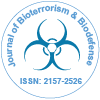当社グループは 3,000 以上の世界的なカンファレンスシリーズ 米国、ヨーロッパ、世界中で毎年イベントが開催されます。 1,000 のより科学的な学会からの支援を受けたアジア および 700 以上の オープン アクセスを発行ジャーナルには 50,000 人以上の著名人が掲載されており、科学者が編集委員として名高い
。オープンアクセスジャーナルはより多くの読者と引用を獲得
700 ジャーナル と 15,000,000 人の読者 各ジャーナルは 25,000 人以上の読者を獲得
インデックス付き
- CAS ソース インデックス (CASSI)
- 索引コペルニクス
- Google スカラー
- シェルパ・ロミオ
- Jゲートを開く
- Genamics JournalSeek
- アカデミックキー
- ジャーナル目次
- 研究聖書
- 中国国家知識基盤 (CNKI)
- ウルリッヒの定期刊行物ディレクトリ
- レフシーク
- ハムダード大学
- エブスコ アリゾナ州
- OCLC-WorldCat
- SWBオンラインカタログ
- パブロン
- ジュネーブ医学教育研究財団
- ユーロパブ
- ICMJE
役立つリンク
オープンアクセスジャーナル
このページをシェアする
抽象的な
Prioritizing Countries by Concern Regarding Access to Weapons of Mass Destruction Materials
Susan Caskey, Barry Ezell*
This article presents a global prioritization methodology that evaluates the relative risks of non-state actor acquisition of materials that could be used in chemical, biological, radiological, nuclear and high explosive Weapons of Mass Destruction (WMD) from the country’s relevant infrastructure. Prioritization is based on three domains: 1. Assessing relative scale of materials in each country, 2. The country’s corresponding security posture, and 3. The presence of threat actors. The output is a list of countries prioritized from greatest risk to least. Rather than providing an overall 1 to N ranking, however, the results are placed into tiers based upon their natural groupings within the three domains. The countries in the highest tiers are flagged as potential US national security concern; those scoring in the middle and at the bottom are flagged as posing lower US national security concern. A systematic approach assesses each country by leveraging many disciplines, such as risk and decision analysis, as well as expert judgement. A quantitative value model based on Multi-Attribute Value Theory (MAVT) organizes the objectives scoring criteria into a value tree using lessons learned from previous studies, published literature, and expert judgement. The article presents the prioritization categories and corresponding value model scoring criteria to include measurement type, weight, range, and value preference. Country names and data are notional in order to share the details on the underlying methodology and model without identification of actual security risks. A deliberative process addresses factors external to the model and scrutinizes inputs, methodology, model, and results

 English
English  Spanish
Spanish  Chinese
Chinese  Russian
Russian  German
German  French
French  Portuguese
Portuguese  Hindi
Hindi